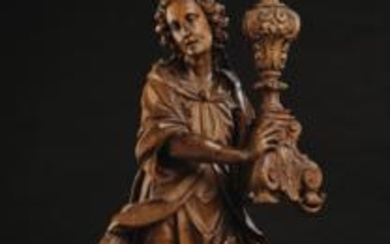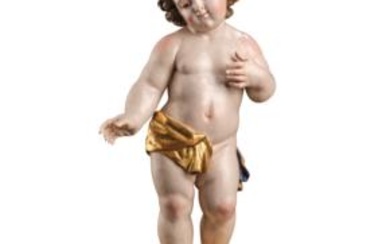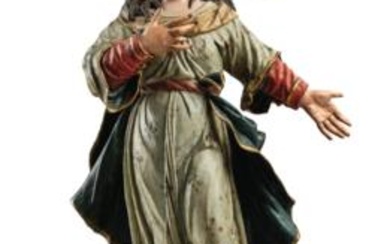ANGEL'S HEAD in limestone carved in the round. Oval face with regular features with eyes stretched out in length, upper eyelids slightly curved, lower eyelids straight, eyeballs slightly protruding, nose long and fine, mouth well defined with lower...
ANGEL'S HEAD in limestone carved in the round. Oval face with regular features with eyes stretched out in length, upper eyelids slightly curved, lower eyelids straight, eyeballs slightly protruding, nose long and fine, mouth well defined with lower lip set back, chin prominent and heavy; hair shared by a median parting falling into the neck; strands strongly wavy around the face, spreading out at the sides and at the temples; a small strand is at the height of the ears at the back of the cheeks.
Picardy or Normandy, second half of the 13th century
Height: 29,5 cm - Depth: 20,5 cm Black marble
base (slight accidents and erosion)
Origin: bought 52 years ago from a Parisian dealer by the collector.
Works consulted: Exhibition Châlons-en-Champagne 2006, Regards sur l'art médiéval, Musée des Beaux-arts et d'Archéologie, cat.; Exhibition New
York 2007, Set in Stone - The Face in Medieval Sculpture, The Metropolitan Museum, cat. Aubert, La sculpture française au Moyen Age, Paris, 1946;
F. Joubert, La Sculpture gothique en France XIIe-XIIIe siècles, Paris, 2008; Exhibition Paris 2010, Paris ville rayonnante, Musée de Cluny - musée national du
Moyen Age, M. Cohen and X. Dectot, cat.
This angel's head, of natural size, belonged to a large statue similar to those adorning the portals of cathedrals. Its strict frontality and its expression of impassive serenity are similar to those of the imposing angel's head from the first quarter of the 13th century kept in the museum of Cluny, which comes from Notre-Dame (inv. CL. 22969, fig.a). It is indicated as having belonged to an angel from the left side of the Coronation of the Virgin's portal accompanying a statue of Saint Denis. It should be noted that this representation is very different from the expressiveness of the two angels "with a smile", around 1240, who originally framed a figure also of St. Denis at the portal of Rheims (fig. b). Finally, it may also be the head of an angel of the Annunciation, which sometimes displays a great impassivity, as shown in the Amiens Cathedral in the 1230s (fig. c).
From a stylistic point of view, this head seems a little later than these previous examples. The oval of the face, the eyes tapering towards the temples, the curls of the hair, the heaviness of the chin are characters that can be seen on a head of a Theological Virtue of Our Lady dated before 1258 (Cl.23128, fig.d). However, these characters are interpreted with force, the models more assertive, the expression wrinkles well marked. Here everything is softened with the just suggested eyebrow arches, the eyes barely protruding, the corners of the mouth full of lips that give an idealization to this angelic representation; we are still far from the stereotyped features that the statuary later adopts in the fourteenth century. Its precise location is not easy to establish. The nature of the stone given by Annie Blanc, a geologist, after analysis in cathodoluminescence sheds some light on the subject: it is in fact a "fine white micritic limestone of the white chalk type from Normandy or Picardy". Automatically translated by DeepL. To see the original version, click here.
View it on
Estimate
Time, Location
Auction House
ANGEL'S HEAD in limestone carved in the round. Oval face with regular features with eyes stretched out in length, upper eyelids slightly curved, lower eyelids straight, eyeballs slightly protruding, nose long and fine, mouth well defined with lower lip set back, chin prominent and heavy; hair shared by a median parting falling into the neck; strands strongly wavy around the face, spreading out at the sides and at the temples; a small strand is at the height of the ears at the back of the cheeks.
Picardy or Normandy, second half of the 13th century
Height: 29,5 cm - Depth: 20,5 cm Black marble
base (slight accidents and erosion)
Origin: bought 52 years ago from a Parisian dealer by the collector.
Works consulted: Exhibition Châlons-en-Champagne 2006, Regards sur l'art médiéval, Musée des Beaux-arts et d'Archéologie, cat.; Exhibition New
York 2007, Set in Stone - The Face in Medieval Sculpture, The Metropolitan Museum, cat. Aubert, La sculpture française au Moyen Age, Paris, 1946;
F. Joubert, La Sculpture gothique en France XIIe-XIIIe siècles, Paris, 2008; Exhibition Paris 2010, Paris ville rayonnante, Musée de Cluny - musée national du
Moyen Age, M. Cohen and X. Dectot, cat.
This angel's head, of natural size, belonged to a large statue similar to those adorning the portals of cathedrals. Its strict frontality and its expression of impassive serenity are similar to those of the imposing angel's head from the first quarter of the 13th century kept in the museum of Cluny, which comes from Notre-Dame (inv. CL. 22969, fig.a). It is indicated as having belonged to an angel from the left side of the Coronation of the Virgin's portal accompanying a statue of Saint Denis. It should be noted that this representation is very different from the expressiveness of the two angels "with a smile", around 1240, who originally framed a figure also of St. Denis at the portal of Rheims (fig. b). Finally, it may also be the head of an angel of the Annunciation, which sometimes displays a great impassivity, as shown in the Amiens Cathedral in the 1230s (fig. c).
From a stylistic point of view, this head seems a little later than these previous examples. The oval of the face, the eyes tapering towards the temples, the curls of the hair, the heaviness of the chin are characters that can be seen on a head of a Theological Virtue of Our Lady dated before 1258 (Cl.23128, fig.d). However, these characters are interpreted with force, the models more assertive, the expression wrinkles well marked. Here everything is softened with the just suggested eyebrow arches, the eyes barely protruding, the corners of the mouth full of lips that give an idealization to this angelic representation; we are still far from the stereotyped features that the statuary later adopts in the fourteenth century. Its precise location is not easy to establish. The nature of the stone given by Annie Blanc, a geologist, after analysis in cathodoluminescence sheds some light on the subject: it is in fact a "fine white micritic limestone of the white chalk type from Normandy or Picardy". Automatically translated by DeepL. To see the original version, click here.







